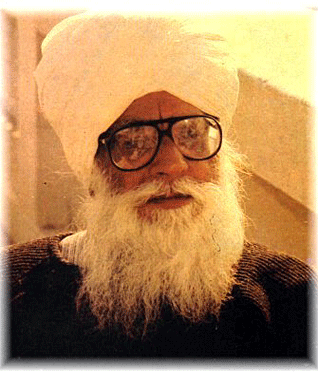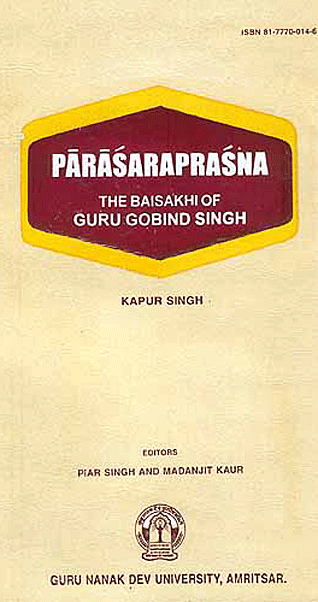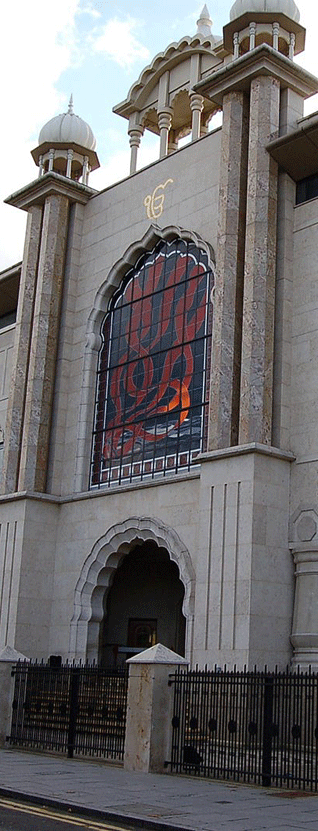
Above, and the first image from the bottom: photos of the Gurdwara in Southall, London, England - courtesy, Spheric M.

Sirdar
Kapur
Singh


Columnists
The Voice of a Nation
A Book Review of Sirdar Kapur Singh's PARASARAPRASNA
by MANJYOT KAUR
PARASARAPRASNA, by Kapur Singh. Guru Nanak Dev University, Amritsar, 2001 (3rd ed.). ISBN 81-7770-014-6. 319 pages. Price: Rs. 250.
This book was conceived in 1950, during a period of what the author qualifies as "forced leisure and detention" at Simla, in the foothills of the Himalayas, where he had come on holiday.
In the course of this stay, which was lengthened by circumstances into a semi-permanent one, Sirdar Kapur Singh met an old friend, Sri Sardari Lal Parasara, Principal of Simla's Government School of Arts. For more than a year, the two men made a practice of enjoying long walks and talks together in the rugged woods and snows.
Out of this scholarly intercourse was Parasaraprasna ("The Questions of Parasara") born.
The masterwork of Kapur Singh, National Professor of Sikhism and considered by many to be the faith's outstanding theologian, its every page radiates his amazingly profound erudition and insightful interpretations of various aspects of Sikh identity and institutions.
Indisputably a true "leading light" of Sikhi, he possessed an intellectual arsenal of staggering proportions which he displays most impressively throughout the book, adroitly connecting a mind-blowing array of esoteric and seemingly disparate "dots", in an absolutely awesome comparative study of world religions.
I have not undertaken here to write a formal, comprehensive review of Parasaraprasna; that did not seem appropriate, given it was first published in 1959. The following simply underscores some of the myriad highlights of this work, characterized by its author as "An enquiry into the genesis and unique character of the Order of the Khalsa with an exposition of the Sikh Tenets".
Right from the very first chapter, "The Baisakhi of Guru Gobind Singh", the author puts forth Sikhi as a completely unique religion, utterly at variance with Hinduism, embarking on a lengthy discussion of how the Tenth Master specifically repudiated the latter's four major traditions. In prescribing a new way of life and creating a distinct people owing allegiance to no earthly sovereign or power, the Order of the Khalsa gave rise to a "Third Panth", totally divorced from the Aryan and Semitic religions, "dedicated to the achievement of political ends aimed at the eventual establishment of a universal and egalitarian global community".
Out of the next group of chapters, dealing with even the most arcane aspects of the transformation of a Sikh into a Khalsa, pre-eminent is the one explaining the injunction of keeping long, unshorn hair, the breach of which is viewed more seriously than any other.
Grounding his arguments in "the metaphysical postulates of transcendental aesthetics" (a typical Kapur Singh-like turn of phrase!) and - as he does throughout the book - lavishly studding them with quotes from Gurbani, the author spares no effort to portray the human body as "nothing less than a microcosm of the entire Cosmos". Furthermore, he integrally identifies the beauty of the body's pristine, complete form with holiness and the Godhead itself.
Equally inspiring sections regarding Guru Granth Sahib and the Rite of Amrit soon follow. In the former, Kapur Singh characterizes the Shabd as "the only authentic portrait of the Guru" and "a perceivable record of revealed transcendental wisdom", the acceptance of which leads to beholding the Guru Himself, attaining comprehension of the Truth, and becoming one with it.
In a chapter intriguingly named "Parthenogenesis" (often likened to virgin birth), he terms Amrit chaknaa "the mystery of baptism of the Pure Steel", a "uniquely regenerative act of communion and union with God", engendering a new creation committed to Truth, and "releasing ever-expanding forces of love and service and strength, to form the basis of a new heaven on Earth".
Kapur Singh's monumental knowledge of mythology, world history and comparative religion is in full evidence throughout the concluding chapters. Securing the balance between Church and State, repudiating the Hindu caste system and extolling the Sikh institution of Ardas, the congregational prayer, are just some of the plethora of topics touched upon here.
Like almost every other issue treated in earlier parts of the book, all of these propel the author into immense, sweeping tangents, multi-page discourses which afford the reader dazzling - and often dizzying - glimpses of the labyrinthine twists and turns so innate to his convoluted thought processes. I must confess that while in their thrall, it would not be hyperbole to say that I often felt as if I were astride a runaway horse galloping at breakneck speed, while I simply tried to hang on for dear life!
To give but one example: in what other tome could one possibly find an interpretation of the significance of Guru Gobind Singh's "vision-inducing" jeweled aigrette, an analysis of the effects of colors on the mind, and an exegesis of the "extra-psychical perceptions" provided by yogic disciplines and hallucinogenic drugs presented in such rapid-fire succession?
Dear readers, if all of the above sounds just a bit too formidable for your liking, buck up and be brave! Delving into this book need not be done gingerly, as a "walking on quicksand" experience. In the words of the Introduction to its first edition, Parasaraprasna is, indeed, a "tour de force of living adoration of the Master".
Sikhs of all stripes (and not just those who strictly adhere to Maryada) may justifiably glory in the descriptions of the incomparable beauty and true uniqueness of our faith; non-Sikhs will certainly find much that enlights and delights.
While this work is seldom a gaping door, once prized open, there is genuine treasure to be found for those intrepid enough to explore its pages.
December 28, 2007
Conversation about this article
1: Inni Kaur (Fairfield, CT, U.S.A.), December 29, 2007, 9:00 AM.
Manjyot, thanks for introducing me to this book. Seems to be a book that every Sikh home should own. Any suggestions from where I can get a copy? [Editor: Singh Brothers in Amritsar; Saccha Sauda in Brampton, Canada.]
2: Mohkam Singh (Paris, France), December 29, 2007, 10:18 AM.
Thanks for bringing this book to the fore, and so brilliantly! Kapur Singh has indeed been lost to the current generation, and it is a great service to re-introduce him to the Sikh masses: he is indeed a clear voice of reason and wisdom.
3: Harpreet Singh (Cambridge, MA, U.S.A.), December 29, 2007, 4:16 PM.
Dear Manjyot: Thank you for reviewing perhaps the most important work on Sikh theology in the past century. I can attest to the same exhilaration that you mention each time I revisit this book. Sirdar Kapur Singh is an inspiring figure. He writes from outside the academy with meager resources, yet he offers us an original interpretation of Sikh thought, one that owes much to the Prachin Panth Prakash (1841) of Rattan Singh Bhangu and literature of the Gurbilas genre. After the "domestication" of the Sikhs by the British, in our love-affair with modernity that encourages individualism at the expense of the concept of the Panth, we have completely ignored works such as the Panth Prakash, which forcefully articulate the significance of the Khalsa. Kapur Singh provides us with a synthesis of this thought and makes it relevant to our present circumstances. Another one of his essential works worth mentioning is the Sachi Sakhi (in Panjabi), which is considered by some as the "political bible" of the Sikhs for its cogent articulation and analysis of issues faced by Sikhs of India as they progressively became second-class citizens in the post-colonial period. As the author of the important "Anandpur Sahib Resolution", and as an Indian Civil Service (ICS) officer who had privileged access to information (for example, as a Deputy Commissioner, his interception of the then Panjab Governor Chandu Lal Trivedi's secret memo in 1947 that declared all Sikhs to having "criminal tendencies", in deference to the wishes of Jawahar Lal Nehru and Sardar Patel), Kapur Singh remains an important source on Sikh political philosophy that is grounded in real-life experiences of his community.
4: Amrik Singh (New Delhi, India), December 29, 2007, 5:04 PM.
Manjyot ji: It would delight us all - and we'll all benefit from it immensely - if you'll review Kapur Singh's other masterpieces and show us the way through them. It is such a delight to read your analyses. We are deeply indebted to you.
5: Rehmat Kaur (Maner, India), December 29, 2007, 5:09 PM.
Have heard about Sirdar Kapur Singh from time to time, but had never read him. Looks like it's been my loss. It now sits atop my new year's resolutions! Thanks.
6: Satvir Kaur (Boston, U.S.A.), January 02, 2008, 9:23 AM.
Thanks for introducing this book to me. Sometime back, I read Kapur Singh's "Sachhi Saakhi". What a read! So thorough. I must admit it was not an easy read. I had to read many chapters twice or thrice. But the depth of analysis, all the informaion and the theology, is simply mind blowing. He is one my favorite Sikh personalities now.
7: Satwinder Singh (Dublin, Ireland), January 15, 2008, 12:53 PM.
Thanks, Manjyot ji, for an excellant review of Sardar Kapur Singh's book. This will certainly encourage readers to read and help them appreciate the excellent work of this extraordinary man.
8: Gurdit Singh (Kansas City), January 25, 2008, 11:07 AM.
Thank you for reviewing this masterpiece by Sirdar Kapur Singh. I, too, have revisited this book many times and every time I come back to it, I learn something new or acquire more astute insights into the multi-layers of the Sikh tradition. While I welcome the subsequent editions published by Guru Nanak Dev University in Amritsar, I lament the the freedoms taken by the editors to change some of Kapur Singh's original text.


